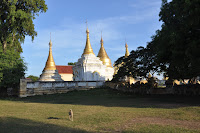(...)
The moment we approached the rather exquisite Bagaya Kyaung teak monastery I felt we were fortunate to come across such an unexpectedly well preserved (at least in terms of appearance) building bearing in mind the fact that it dates back to 1593 and once formed the far Southern corner of the Royal enclave close to the confluence of the Ayeyarwady and Myitnge rivers.
The woodcarving was rather interesting as the doorways, window frames, partitions and even some pillar bases were richly carved in Burmese style combining floral arabesques with reliefs of birds, animals and figures from Buddhist mythology.
Its interior was mostly gloomy, with just two splashes of luminosity, one on a glass-inlaid lacquered trunk (I took a picture of, which didn't come out right) and the image of a Buddha wearing a gold leaf covered blanket on his shoulders.
A total of 267 massive pillars (whose size can be seen in some of the photos I have taken) support the building, whose seven storeys denote its former Royal status.
A total of 267 massive pillars (whose size can be seen in some of the photos I have taken) support the building, whose seven storeys denote its former Royal status.
As we were being transported back on the horse carts we sighted numerous pagodas and the 27 metre high Nanmyin Watchtower also known as the "leaning" tower of Inwa before we stopped at the Mahar Aung Mye Bon San monastery, a tall stucco-decorated brick structure dating to 1818.


Prior to making the last part of the horse-cart journey following one of the colleagues'discoveries I quickly made my way towards one of the sides of the monastery so as to photograph some well preserved stupas
We briefly stopped at a local's (a straw "weaved"one storey high structure) to buy bananas for the following all day long boat trip on the river Ayeyarwardy


























No comments:
Post a Comment